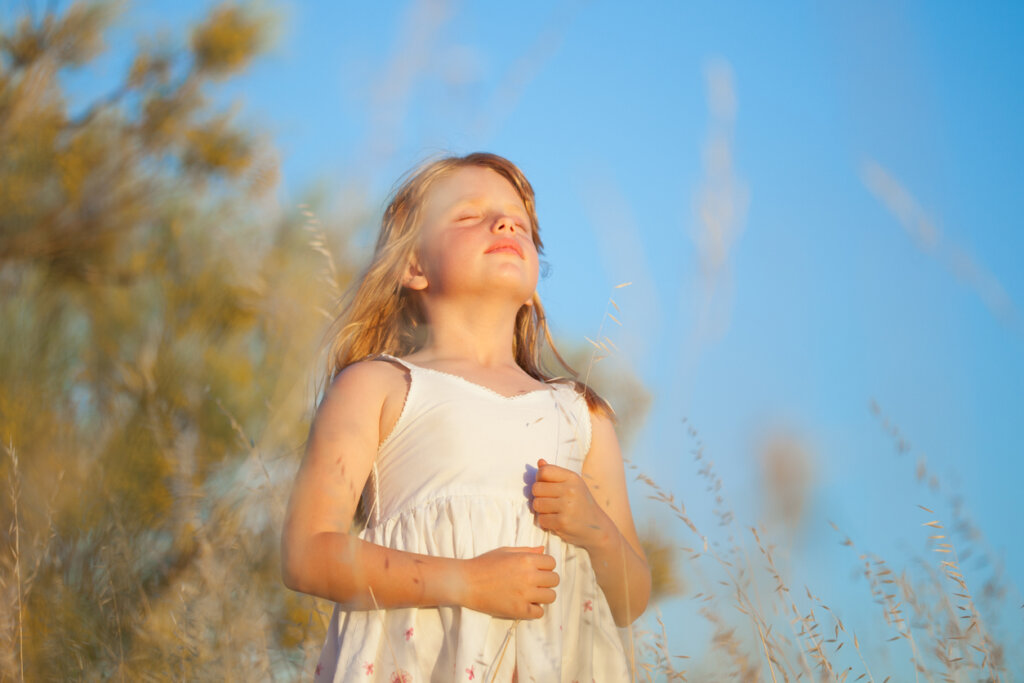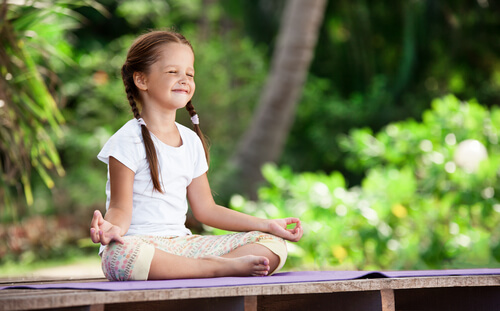Stress can affect children. Therefore, providing them with strategies like mindfulness helps them better handle adverse situations and have a better quality of life in the future. In this article, we’ll suggest five short exercises.
Mindfulness is potentially an important pathway toward emotional self-regulation. This means it allows infants to self-regulate by directing the focus of their attention in a specific way. In effect, they entirely focus their awareness nonjudgmentally on what comes to mind in the here and now.
“Mindfulness is an important skill that we can teach children to help them manage their emotions and improve their mental well-being.”
-Mark Bertin-
The powerful tool of mindfulness
According to research published by the academic publisher, Elsevier, mindfulness provides children with tools to deal with stressful situations without trying to modify the experience of discomfort (Perry-Parrish et al., 2016). This is important, as our immediate reactions tend to be to try to reduce or eliminate painful experiences.
However, the purpose of mindfulness is to achieve a balance between the desire to be better and the conscious and voluntary acceptance that pain is inevitable and intrinsic to being human.
Due to childhood stress, certain psychological consequences may remain (Perry-Parrish et al., 2016). These could be internalizing problems, such as depressive disorders, or externalizing problems, such as disruptive disorders.
“Mindfulness instruction has been shown to improve mental health and quality of life.”
-Carisa Perry-Parrish-
Mindfulness exercises for children
Recently, the General Council of Spanish Psychology, via the Infocop website, published a mindfulness guide for children. It includes some simple exercises for practicing mindfulness. Here are five of them.
1. Throwing flowers
Tell your child to imagine that they’re picking 20 flowers in a field. Then, they sit down on a large stone in the middle of the road. Now, they should immediately close their eyes and pay attention to their breathing. When they breathe in, they should imagine they’re picking up a flower. When they breathe out, they must imagine they’re throwing a flower away.
2. Ringing a bell
Have them ring a handbell and listen until the sound fades away. Did they close your eyes? Did they get distracted? Or, did they think of something in particular? If their attention drifted to other stimuli, have them repeat the exercise. The goal is that, with practice, they’ll increase their attention span.
3. Giving a massage
Get your child to give you a massage, kneading your flesh like pizza dough. Tell them to rub their hands together well when they’ve finished. Ask them if their hands feel hot and to focus on that feeling. The goal is to come into contact with and be aware of another person’s body.
4. Breathe
Ask them to focus their attention on the flow of air going up and into their lungs. Have them use their breathing as an anchor to the present. If they’re distracted from the task, it doesn’t matter, they can always redirect their attention to the anchoring of their breathing. Tell them to imagine that their lungs are a balloon that expands with the entry of air.
5. Apply the RAIN technique
The self-regulation of emotions involves a series of phases. According to the guide ( Infocop, 2022), the child can use the acronym RAIN as a way of promoting self-regulation:
- Recognize. The infant identifies what emotion they’re feeling. For example, anger or sadness.
- Acceptance. They let go of the emotion, without judging, avoiding, or rejecting it. They should wait until the emotion loses intensity.
- Investigate. They ask themselves in what part of their body they feel the emotion. The answer to this question promotes greater self-regulation through body recognition or the body-scan technique.
- Not turning off. Locating, identifying, and accepting the emotion helps the child not to allow any feelings of discomfort to take over. After observing the emotion, they let it go and continue to do breathing exercises.
“Mindfulness instruction leads to reduced stress and increased self-regulation.”
-Carisa Perry-Parrish-

The effects of mindfulness in childhood
Teaching infants mindfulness and how to live in the here and now is a really valuable lesson. Apart from reducing stress, it gives them better control of their emotional cosmos. Moreover, it gives them a sense of calm that’s essential for living in today’s stressful society.
Mindfulness in childhood allows children to better self-regulate. Research conducted by Dr. Perry-Parrish et al., (2016) identified the following effects of mindfulness:
- Decreased rumination, anxiety, anger, and unpleasant thoughts and emotions.
- Increased adaptive coping strategies. For example, increased self-knowledge, more impulse control, improved attention, and increased cognitive flexibility.
Finally, mindfulness promotes and enhances a greater acceptance of unpleasant events. Along with the above-mentioned benefits, it contributes to an increase in self-awareness. This means that aversive emotions, such as anguish or irritability, instead of being avoided, can be accepted until their intensity decreases.
“Mindfulness instruction aims to enhance an individual’s innate ability to be aware of what is happening internally and externally with open, non-judgmental curiosity.”
-Carisa Perry-Parrish-
The post Mindfulness Exercises for Children appeared first on Exploring your mind.















Comments